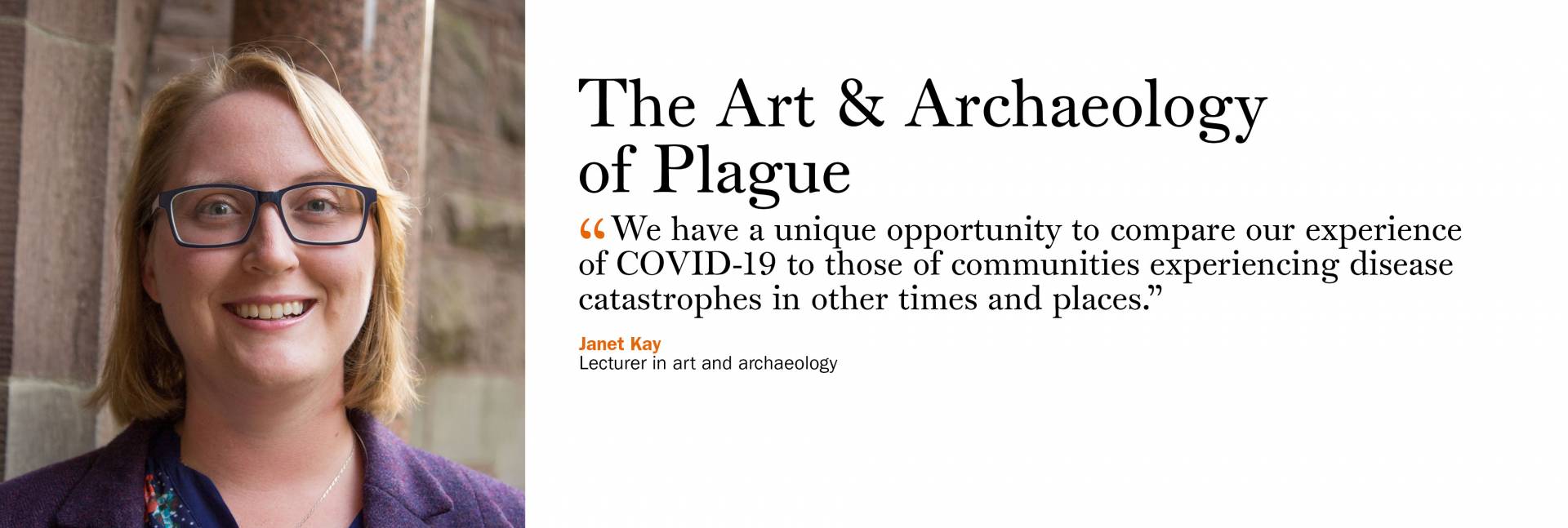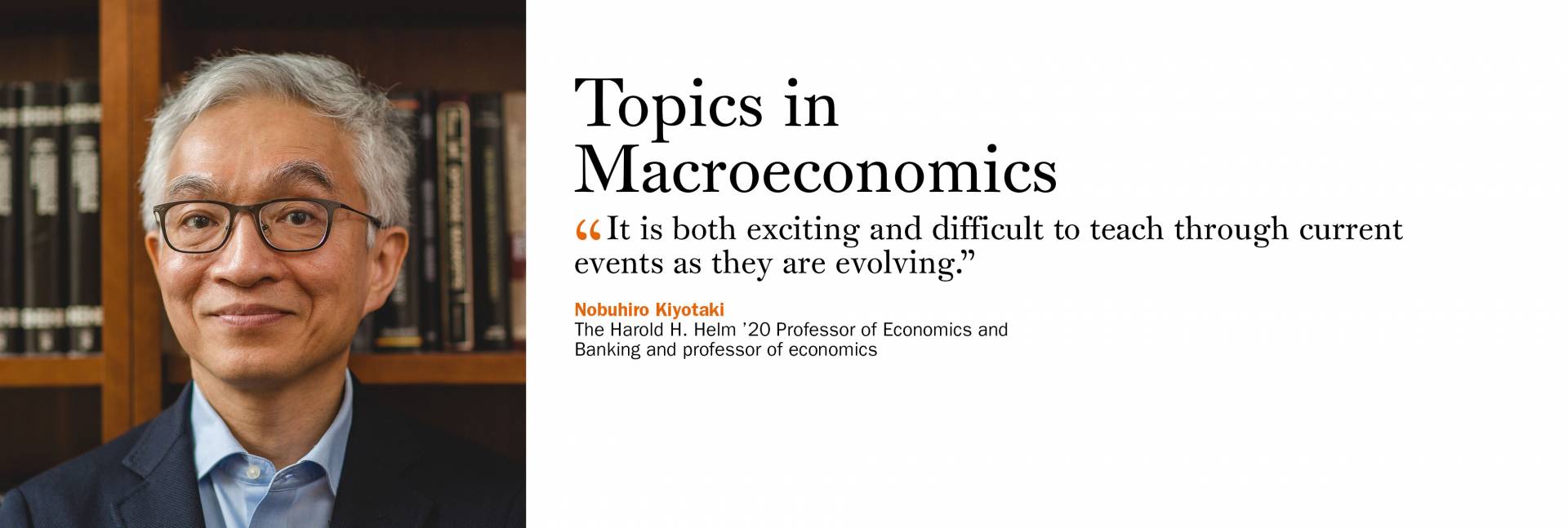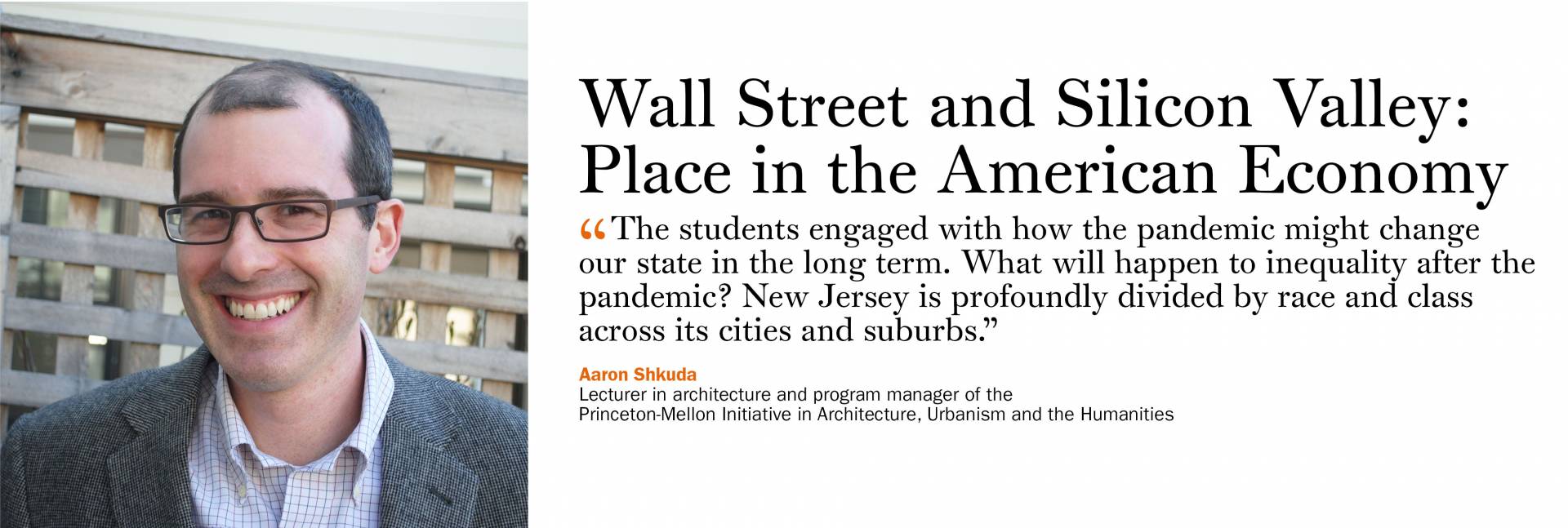In this second installment about teaching the pandemic in real time, four Princeton professors share how they incorporated the coronavirus and the pandemic’s effects into their course material during the spring 2021 semester. Pictured: Janet Kay, lecturer in art and archaeology (left) and Phoebe Warren, a member of the Class of 2021 and a student in Kay's course "The Art and Archaeology of Plague," take a socially distant walk through the courtyard of East Pyne Hall.
The pandemic changed not only how Princeton University students were learning after the transition to remote teaching in March 2020, but also what they were learning — especially as the impact of COVID-19 opened new lines of humanistic and scientific inquiry across fields of study.
In this second installment about teaching the pandemic in real time (read part one), Princeton professors share how they incorporated the coronavirus and the pandemic’s effects into their course material during the spring 2021 semester.
The Art & Archaeology of Plague
Janet Kay, lecturer in art and archaeology
Is this a new course or an existing course?
This is a new course based upon themes and methodologies I’ve encountered in my own research. But I designed it in the midst of the COVID-19 pandemic, and I continued to redesign it in small ways every week (even in week 12!) to adapt to changing questions and issues. We had a unique opportunity to compare our experience of COVID-19 to those of communities experiencing disease catastrophes in other times and places. This helped us better understand the situation in which we find ourselves, and at the same time helped us think more critically about how societies have responded to disease events in the past — and the strengths and weaknesses of the sources we use to study it.
How did you incorporate the COVID-19 pandemic into your curriculum?
In small ways throughout the course, I connected the “plagues” that we studied (smallpox, the Black Death, the 1918 Influenza, malaria, etc.) to our experiences of COVID-19. We also focused on COVID-19 in our last week of the course, especially in the context of the ways in which fear of a disease and the misunderstood or perceived “origins” of a disease can lead to xenophobia and racism. This is an issue with which we are all too familiar in 2020-21, but which is unfortunately not a new phenomenon in human history.
What are the advantages and/or the challenges of teaching a subject that is unfolding in real time?
The biggest challenge was fitting all of the content I wanted to cover into one 12-week course. Especially one that was online and prerecorded. So much recent research about the art and archaeology of disease is really changing the way that we can study the past. But there was ultimately a metanarrative to these challenges in constructing the course as well. One of the key frameworks of this semester was studying how scientific knowledge production and transmission changed in response to disease events. The fact that we are all doing the best that we can with Zoom is an example of how we are literally living the phenomenon we are studying.
The main advantage to teaching about pandemics in the COVID-19 era is that students can directly understand why it is important to study disease events in the past. Throughout the course, we considered the role of fear in societal responses to disease, and the ways in which these responses can have devastating effects on minority social and ethnic groups. But we also considered how societal responses to disease can bring a community together and cause positive social change.
We looked at the historical origins and applications of a lot of concepts with which students have a lot of experience these days: quarantine procedures, restricted access to the basic necessities of everyday life, social stress and isolation, mental health concerns, etc. We also thought about how our study of past disease events impacts our current moment — and vice versa. Towards the end of the semester, for example, we compared maps of COVID-19 infection rates and mortality in comparison with John Snow’s 1854 map of the Broad Street Pump during a cholera outbreak in London.

What resources have been especially useful to you or key to your teaching?
This course would not have been possible without the five excellent graduate student AIs from art and archaeology (Nomi Schneck), comparative literature (Friederike Ach), and history (Megan Baumhammer, Corinne Kannenberg and Valerie Piro). This was a large lecture course of about 100 students, and it would have been impossible to teach all students effectively over Zoom if these talented women had not stepped up to the task in the way that they did.
Having so many different disciplinary perspectives in teaching this course was also incredibly important: students who were in this course are pursuing majors in the humanities, the social sciences, the natural sciences, and engineering and applied sciences. This disciplinary diversity was crucial to the success of the course, both in teaching and in student participation.
How did students react to the material? How did it reflect their lived experiences?
I found that students interacted on a personal level with the concepts that this course raised. One of the learning strategies that I used to encourage this kind of deep critical thinking was a series of “Plague Simulation” assignments. Working in their precept groups, and within the medical mindset of the historical time period for each assignment, students developed action plans to save Princeton University and the town from disease events like the Antonine Plague and the Black Death. This meant thinking like an ancient or medieval physician — using treatments like bloodletting and concepts from humoral medicine — while acting on the modern campus. The assignment required both textual and visual explanations, which asked the students to put into practice the concepts of knowledge production and dissemination that the course examined. It also gave them a small creative outlet during a stressful semester, which I hope had mental health benefits beyond the primary learning strategy. Many of the solutions that the students proposed, such as an app to track symptoms of smallpox, drew from their experiences of the University’s COVID-19 protocols.
This course also dealt with the question of how societies in the past dealt with increasing death rates, which was a very personal issue at a time when so many of our students, faculty and staff have lost loved ones to COVID-19. When visiting each of the precepts, I was struck by how individualized the discussions were, and the depth to which students were willing to push their boundaries to engage with questions and situations that reflected their lived experiences. Overall, the students rose to the challenges that this course — and this year — presented.
Topics in Macroeconomics
Nobuhiro Kiyotaki, the Harold H. Helm ’20 Professor of Economics and Banking and professor of economics
Is this a new course or an existing course?
This is an existing course, and I incorporated the COVID-19 crisis as an example of my general topics of interaction between aggregate fluctuations and the adjustment of the balance sheets of households, non-financial businesses and financial intermediaries. The course uses economic theory to study credit cycles, financial crisis and public policy.
What are the advantages and/or the challenges of teaching a subject that is unfolding in real time?
It is both exciting and difficult to teach through current events as they are evolving because we need to be cautious about the present explanations as future data may refute our explanations.

What resources have been especially useful to you or key to your teaching?
I find the webinar series Markus’ Academy by my colleague in the economics department Markus Brunnermeier [the Edwards S. Sanford Professor of Economics and director of the Bendheim Center for Finance] very useful.
How does the COVID-19 pandemic speak to larger issues in your field?
The COVID-19 crisis may exacerbate the inequality and the secular stagnation [a lack of economic growth] in the United States and some other countries, even though the outcome is uncertain now.
Wall Street and Silicon Valley: Place in the American Economy
Aaron Shkuda, lecturer in architecture and program manager of the Princeton-Mellon Initiative in Architecture, Urbanism and the Humanities
Is this a new course or an existing course?
I first taught this course in 2018, and again in 2020, as the University went into lockdown. In that version of the seminar, and in spring 2021, the pandemic brought new urgency to the core questions that shape the class: How and why does place matter in the American economy? Why do traders commute from expensive New York neighborhoods and exclusive suburbs to offices in Lower Manhattan when all their transactions are electronic and no longer rely on a trading floor like the New York Stock Exchange? Why do chartered buses take thousands of engineers to office parks in Silicon Valley when they are the ones creating technologies that make virtual work possible?
How did you incorporate the COVID-19 pandemic into your curriculum?
We didn’t have a separate COVID-19 unit in the class, but the pandemic and the move of the bulk of highly skilled, white-collar work to remote settings shaped our discussion in nearly every session. The students read news articles about the changing nature of work and the future of cities to supplement our academic texts. So many of the ideas that frame the course, from Richard Florida’s idea of the creative class to Saskia Sassen’s work on the global city, are based on the idea that the workers who are critical to contemporary economy need to work in close proximity. This allows them to share ideas, drive innovation and have fulfilling social lives that complement their work. The pandemic has thrown all this into question. How does our understanding of cities change if you do not have to live in the New York area to work “on Wall Street?” If engineers at companies such as Google no longer need to commute to Silicon Valley, will they want to live in the Bay Area? What is going to happen to the skyscrapers and amenity-filled corporate headquarters that define finance and tech, and help companies attract workers, if the bulk of the workforce is working remotely?

What are the advantages and/or the challenges of teaching a subject that is unfolding in real time?
The advantages are that we all have experienced what we are studying. Students can speak to the experience of having a remote internship and can compare it to the experience of being in the same building as their coworkers or peers. I even have a student who is going to work for an all-virtual company next year that has created a virtual office that seeks to mimic some of the dynamics of built office space. The downside is that, after more than a year, the students are tired of talking about COVID-19 and want a return to normalcy. But the topic of the course didn’t allow us to turn away from this issue for too long.
What resources have been especially useful to you or key to your teaching?
The class is organized in collaboration with Princeton’s Program for Community Engaged Scholarship (ProCES), and for their final projects the students completed research in conjunction with nonprofits in New Jersey. The students engaged with how the pandemic might change our state in the long term. For the most densely populated, suburban state in the U.S., what will happen if fewer commuters travel to New York and Philadelphia in the future? Will it help make our air cleaner and preserve our infrastructure, or will it bankrupt our transit agencies and local governments? Might there be opportunities to encourage the development of smaller, walkable regional centers if fewer people commute? What will happen to inequality after the pandemic? New Jersey is profoundly divided by race and class across its cities and suburbs. Tools like online mapping programs and digital archives have also been critical in helping the students engage with the material.
How does the COVID-19 pandemic speak to larger issues in your field?
The pandemic has raised many new questions in urban studies, but it’s also brought us back to fundamental issues in the field. Though there was some misattribution of the severity of the pandemic in New York to the city’s density, it’s clear that urban life does not cause (or exacerbate) the pandemic. Just look at how Seoul and Tokyo have fared over the past year. Yet, it is clear that racial inequality in the city, and the increasingly stark contrasts between highly compensated white-collar work and “essential” service employment, shaped the unequal ways that the pandemic has affected low-income communities and communities of color. Living in overcrowded housing, or not being able to access park space, also made a difference in outcomes. We are now facing a looming eviction crisis, and it’s unclear how low-wage work in sectors like hospitality will rebound. These questions, along with the long overdue reckoning with racial justice in so many cities and suburbs, will shape the way we study cities both in the short and long term.
The Media in America: What to Read and Believe in the Time of COVID-19
Joe Stephens, lecturer in the Council of the Humanities, Ferris Professor of Journalism and director of the Program in Journalism
Is this a new course or an existing course?
This is an extensive revamping of a course I have taught in recent years under the name “The Media in America: What to Read and Believe.” It’s an exploration of news literacy, combined with an examination into the challenges and opportunities that journalism faces in the digital age.
How did you incorporate the COVID-19 pandemic into your curriculum?
The pandemic, and related issues in the news today, were a huge part of the course. When the pandemic struck, I swapped out most previous reading for examples drawn from the best and worst reporting on COVID-19, social justice, political polarization and the like. In class, the students and I worked together to develop strategies for becoming a confident consumer of the news during the continuing “infodemic” — the sudden tsunami of conflicting information about so many important subjects in modern life, including the pandemic, the presidential election and political protests.

What are the advantages and/or the challenges of teaching a subject that is unfolding in real time?
Our use of live examples — some articles published as recently as a day or two before our class — transformed our discussions about the role of journalism in a participatory democracy into visceral, three-dimensional debates about subjects that were, in some cases, literally matters of life-and-death.
What resources have been especially useful to you or key to your teaching?
We draw on reporting by big news organizations like The New York Times and The New Yorker. And we also draw on sources like Twitter, and your uncle’s Facebook postings. Nothing is off limits; we even spent a lot of time discussing whether TikTok can be used effectively to attract and inform readers about important developments in society.
How does the COVID-19 pandemic speak to larger issues in your field?
Nothing could better demonstrate how important it is to deliver verified facts to citizens in real time. Can you contract COVID-19 from touching a doorknob? Are all vaccines safe? Is there a curfew in my town? In Iran, more than 700 people died after drinking a deadly form of alcohol that they believed could cure COVID-19. That tragedy was, as much as anything, a failure of local journalism to educate citizens.
How did students react to the material? How did it reflect their lived experiences?
You would have to ask my students. But I believe this semester we had some of the deepest and most engaging discussions that I’ve seen in the classroom. We’re all living this epidemic together in real time, and everybody has something to contribute about how journalism has fallen short or helped them through this challenging period.







